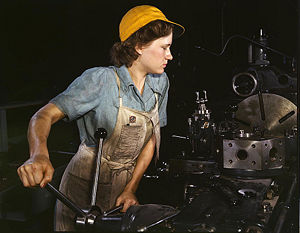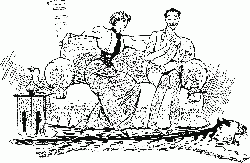A gender role is a set of behavioral norms associated particularly with males or females in a given social group or system, often including the division of labor between men and women and the attendant complex of child-rearing and socialization processes leading youth toward maturing to perpetuate the same pattern. Gender-based roles coincident with sex-based roles have been the norm in many traditional societies, with the specific components and workings of the gender/sex system of role division varying markedly from society to society. Gender role is a focus of analysis in the social sciences and humanities.
A person's gender role comprises several elements that can be expressed through clothing, behavior, occupation, personal relationships, and other factors. These elements are not fixed and have changed through time (for example, women's trousers). Gender roles traditionally were often divided into distinct feminine and masculine gender roles, until especially the twentieth century when these roles diversified into many different acceptable male or female roles in modernized countries throughout the world. Thus, in many modern societies one's biological gender no longer determines the functions that an individual can perform, allowing greater freedom and opportunity for all people to achieve their individual potential and offer their talents and abilities to society for the benefit of all.
The flux in gender roles in modern societies plays against the biological givenness of the woman as the bearer of the child and is one of the factors contributing to the low rates of birth in countries ranging from Germany to Japan. Within the family in modern societies there remains considerable flux, reflecting the continued confusion about such lifestyle issues as marriage partners, sexual love, and the structure of families. Establishing stable, peaceful, and happy societies in the twenty first century will require new thinking about gender roles that accord priority to the family raising up balanced children benefiting from both the masculine and feminine strengths of their parents.
Theories
Gender roles have long been a staple of the "nature versus nurture" debate. Traditional theories usually assume that one's gender identity, and hence one's gender role, is a natural given. The idea that differences in gender roles originate in differences in biology has found support in parts of the scientific community. Nineteenth century anthropology sometimes used descriptions of the imagined life of paleolithic hunter-gatherer societies for evolutionary explanations of gender differences. For example, those accounts maintain that the need to take care of offspring may have limited the females' freedom to hunt and assume positions of power.
Due to the influence of (among others) Simone de Beauvoir's feminist works and Michel Foucault's reflections on sexuality, the idea that gender was unrelated to sex gained ground during the 1980s, especially in sociology and cultural anthropology. This view argues that a person could be born with male genitals but still be of feminine gender. In 1987, R.W. Connell did extensive research on whether there are any connections between biology and gender role and concluded that there were none.[1] Most scientists reject Connell's research because concrete evidence exists proving the effect of hormones on behavior. However, hormone levels vary, and disorders can cause an intersex status.
Simon Baron-Cohen, a Cambridge University professor of psychology and psychiatry, has said that "the female brain is predominantly hard-wired for empathy, while the male brain is predominantly hard-wired for understanding and building systems." Real world cases, such as David Reimer to whom John Money unsuccessfully reassigned female gender show that raising a child in a cross-sex role does not cause the child to necessarily adapt to that role.[2]
The trend in Western societies toward men and women sharing similar occupations and responsibilities demonstrates the adaptability of both men and women to perform a variety of tasks. While there are differences in average capabilities of various kinds (such as physical strength) between the sexes, the capabilities of some members of one sex will fall within the range of capabilities needed for tasks conventionally assigned to the other sex.
Sandra Lipsitz Bem
Psychologist Sandra Lipsitz Bem developed the gender schema theory to explain how individuals come to use gender as an organizing category in all aspects of their life. It is based on the combination of aspects of the social learning theory and the cognitive development theory of sex role acquisition. In 1971, she created the Bem Sex Role Inventory to measure how well one fits into his or her traditional gender role, by characterizing the personality as masculine, feminine, androgynous, or undifferentiated. She believed that through gender-schematic processing, a person spontaneously sorts attributes and behaviors into masculine and feminine categories. Therefore, individuals process information and regulate their behavior based on whatever definitions of femininity and masculinity the ambient culture provides.[3]
Talcott Parsons
Working in the United States, Talcott Parsons developed a model of the nuclear family in 1955. At that place and time, the nuclear family was considered to be the prevalent family structure. He compared a strictly traditional view of fixed gender roles (from an industrial-age American perspective) to a non-traditional view with more fluid gender roles.
Parsons believed that the feminine role was an expressive one, whereas the masculine role was instrumental. He believed that expressive activities of the woman fulfill "internal" functions; for example, to strengthen the ties between members of the family, whereas the man performed the "external" functions of a family, such as providing monetary support.
The Parsons model was used to contrast and illustrate extreme positions on gender roles. Model A describes total separation of male and female roles, while Model B describes the complete dissolution of barriers between gender roles.[4] (The examples are based on the context of the culture and infrastructure of the United States.)
| Model A-Total role segregation | Model B-Total disintegration of roles | |
| Education | Gender-specific education; high professional qualification is important only for the man. | Co-educative schools, same content of classes for girls and boys, same qualification for men and women. |
| Profession | The workplace is not the primary area of women; career and professional advancement is deemed unimportant for women. | For women, career is just as important as for men; Therefore equal professional opportunities for men and women are necessary. |
| Housework | Housekeeping and child care are the primary functions of the woman; participation of the man in these functions is only partially wanted. | All housework is done by both parties to the marriage in equal shares. |
| Decision making | In case of conflict, man has the last say, for example in choosing the place to live, choice of school for children, buying decisions. | Neither partner dominates; solutions do not always follow the principle of finding a concerted decision; status quo is maintained if disagreement occurs. |
| Child care and education | Woman takes care of the largest part of these functions; she educates children and cares for them in every way. | Man and woman share these functions equally. |
According to the Parson's interactionist approach, roles (including gender roles) are not fixed, but are constantly negotiated between individuals. In North America and southern South America, this is the most common approach among families whose business is agriculture.
Gender roles can influence all kinds of behavior, such as choice of clothing, choice of professional and personal relationships, and parental status.
John Money
Johns-Hopkins psychologist John Money (1921 - 2006) developed the use of gender to describe one's feelings about oneself. His team of researchers determined that people do not have a concrete sense of gender identity until they are at least two years old. According to this team, a child's gender identity can be changed without undue psychological stress. Parsons had an influence on Money's research in that Money used the word gender role rather than sex role to refer to his view that identity is chosen or socially determined rather than biologically caused.
As noted above, however, Money's theories were seriously challenged by the failure of his best-known case, that of David Reimer, in what later became known as the "John/Joan" case. Money reported that he successfully reassigned Reimer as female after a botched infant circumcision performed on Reimer in 1966. Milton Diamond reported in 1997 that the sex reassignment had failed, that Reimer had never identified as female or behaved typically feminine. At age 14, Reimer refused to see Money again, threatening suicide if he were made to go. Despite all of Money's treatments and the conditioning applied to Reimer by his parents to try to make him a female, he began living as male, and at 15, with a different medical team, he sought a mastectomy, testosterone therapy, and a phalloplasty. Later he married a woman who had children from a previous marriage and lived as a man until his suicide at age 38.[5]
Robert Stoller
Robert Stoller focused on gender identity rather than gender role. His work mostly involved transsexuals. Stoller sought to distinguish the self that develops biologically following birth from the self that developed psychologically. He, too, emphasized the role that one's environment plays in the development of one's gender identity, arguing that parents and culture at large were more responsible for gender identity than biological characteristics. Stoller's work was influential on feminists, later arguing against the idea that women were naturally subordinate to men.
Judith Butler
Judith Butler's 1990 work, Gender Trouble, asserted that gender is fluid rather than dichotomous, that gender was an activity one does rather than a trait one has. Butler said that the difference between sexes is only established within a social context and that people create gender, which in turn defines people.
Socialization
The process through which the individual learns and accepts roles is called socialization. Socialization works by encouraging wanted and discouraging unwanted behavior. These sanctions by agencies of socialization, such as the family, schools, and the communication medium, make it clear to the child what behavioral norms the child is expected to follow. The examples of the child's parents, siblings, and teachers are typically followed. Mostly, accepted behavior is not produced by a reforming coercion applied by an accepted social system, although various forms of coercion have been used through history to force the acquisition of a desired response or function.
In the majority of the traditional and developmental social systems, an individual has a choice as to what extent he or she becomes a conformed representative of a socialization process. In this voluntary process, the consequences can be beneficial or malfunctional, minor or severe for every case by a behavior's socialization influence forming gender roles or expectations, institutionalizing gender differences.
Typical encouragements and expectations of gender role behavior are not as powerful a difference and reforming social trait as a century ago. However, such developments and traditional refineries are still a socialization process to and within family values, peer pressures, at the employment centers, and in every social system communication medium.
Still, once someone has accepted certain gender roles and gender differences as an expected socialized behavioral norms, these behavior traits become part of the individual's responsibilities. Sanctions to unwanted behavior and role conflict can be stressful.
Culture and gender roles

Ideas of appropriate behavior according to gender vary among cultures and era, although some aspects receive more widespread attention than others. An interesting case is described by R.W. Connell in, Men, Masculinities, and Feminism:
There are cultures where it has been normal, not exceptional, for men to have homosexual relations. There have been periods in "Western" history when the modern convention that men suppress displays of emotion did not apply at all, when men were demonstrative about their feeling for their friends. Mateship in the Australian outback last century is a case in point.
Other aspects, however, may differ markedly with time and place. In pre-industrial Europe, for example, the practice of medicine (other than midwifery) was generally seen as a male prerogative. However, in Russia, health care was more often seen as a feminine role. The results of these views can still be seen in modern society, where European medicine is most often practiced by men, and the majority of Russian doctors are women.
In many other cases, the elements of convention or tradition seem to play a dominant role in deciding which occupations fit in with which gender roles. In the United States, physicians have traditionally been men, and the few people who defied that expectation received a special job description: "woman doctor." Similarly, there are special terms like "male nurse," "woman lawyer," "lady barber," "male secretary," and so forth. But in China and the former Soviet Union countries, medical doctors are predominantly women, and in the United Kingdom, Germany, and Taiwan it is very common for all of the barbers in a barber shop to be women. Also, throughout history, some jobs that have been typically male or female have switched genders. For example, clerical jobs used to be considered a man's job, but when several women began filling men's job positions due to World War II, clerical jobs quickly became dominated by women. It became more feminized, and women workers became known as "typists" or "secretaries." There are many other jobs that have switched gender roles, and many jobs are continually evolving as far as being dominated by women or men.
It should be noted that some societies are comparatively rigid in their expectations, and other societies are comparatively permissive. Some of the gender signals that form part of a gender role and indicate one's gender identity to others are quite obvious, and others are so subtle that they are transmitted and received beyond ordinary conscious awareness.
Gender roles and feminism
Most feminists have argued that traditional gender roles are oppressive for women. They believe that the female gender role was constructed as an opposite to an ideal male role, and helps to perpetuate patriarchy.
Furthermore, there has been a perception of Western culture, in recent times, that the female gender role is dichotomized into either being a "stay at home-mother" or a "career woman." In reality, women usually face a double burden: The need to balance occupations and child care deprives women of spare time. Whereas the majority of men with university educations have a career as well as a family, only 50 percent of academic women have children.
Transgendered and intersexed people
As long as a person's perceived physiological sex is consistent with that person's gender identity, the gender role of a person is so much a matter of course in a stable society that people rarely even think of it. Only in cases where, for whatever reason, an individual has a gender role that is inconsistent with his or her sex will the matter draw attention.
While the common assumption, that overall in society there is a high degree of consistency among external genitalia, gender identity, and gender role, is accurate, it is also accurate that a small percentage of people due to a combination of their nature and nurture fall into two closely related categories, atypical gender roles and atypical gender identities.
Transgender people may mix gender roles to form a personally comfortable androgynous combination or transcend the scheme of gender roles completely, regardless of their physiological sex. Transgender people can also be physically androgynous or identify as androgynous. Transsexualism also exists, where a person who is born as one sex and is brought up in that sex, has a gender identity of the opposite sex and wishes to live as that gender. Intersex people have a mismatch between their sexual genetic code and their physical make up, which can result in a person have external genitalia like a female and the body physique like a male.
In Western society, there is a growing acceptance of such transgendered and intersexed people. However, there are some who do not accept these people and may react violently and persecute them: This kind of negative value judgment is sometimes known as transphobia. Nevertheless, such cases of mismatch between a person's physiology, identity, and role are relatively rare. A large majority of people have matching genitalia and gender identities and their gender role is commensurate with their genitalia.
Homosexuality and gender roles
Traditional gender roles include male attraction to females, and vice versa. Homosexual, lesbian, and bisexual people usually do not conform to these expectations.
Same-sex domestic partners also challenge traditional gender roles because it is impossible to divide up household responsibilities along gender lines if both partners attempt to fill the same gender role. Like all live-in couples, same-sex partners usually do come to some arrangement with regard to household responsibilities. Sometimes these arrangements assign traditional female responsibilities to one partner and traditional male responsibilities to the other, but non-traditional divisions of labor are also quite common. For instance, cleaning and cooking, traditionally both female responsibilities, might be assigned to different people.
Cross-dressing is also common in gay and lesbian culture, but it is usually restricted to festive occasions, though there are people of all sexual orientations who routinely engage in various types of cross-dressing, either as a fashion statement or for entertainment. Distinctive styles of dress, however, are commonly seen in gay and lesbian circles. These fashions sometimes emulate the traditional styles of the opposite gender (for example, lesbians who wear t-shirts and boots instead of skirts and dresses, or gay men who wear clothing with traditionally feminine elements, including displays of jewelry or coloration), but others do not. Fashion choices also do not necessarily align with other elements of gender identity. Some fashion and behavioral elements in gay and lesbian culture are novel, and do not really correspond to any traditional gender roles, for example, the popularity of rainbow jewelry.
Notes
- ↑ Robert William Connell, Gender and Power (Stanford University Press, 1987).
- ↑ CBC News, David Reimer: The boy who lived as a girl. Retrieved October 24, 2007.
- ↑ Sandra Lipsitz Bem, "Gender schema theory: A cognitive account of sex typing," Psychological Review 88 (1981), 354-364.
- ↑ Brockhaus: Enzyklopädie der Psychologie (2001).
- ↑ Milton Diamond and H.K. Sigmundson (1997) Sex reassignment at birth. Long-term review and clinical implications. Archives of Pediatric and Adolescent Medicine. 1997 Mar;151(3):298-304. Retrieved October 24, 2007.
ReferencesISBN links support NWE through referral fees
- Ahmed, Leila. Women and Gender in Islam: Historical Roots of a Modern Debate. Yale University Press, 1993. ISBN 0300055832
- Brannon, Linda. Gender: Psychological Perspectives. Allyn & Bacon, 2007. ISBN 0205521142
- Butler, Judith. Gender Trouble: Feminism and the Subversion of Identity. Routledge, 2006. ISBN 0415389556
- Connell, R.W. Gender and Power: Society, the Person, and Sexual Politics. Stanford University Press, 1987. ISBN 978-0804714303
- Connell, R.W. Gender (Short Introductions). Polity Press, 2002. ISBN 0745627161
- Disch, Estelle. Reconstructing Gender: A Multicultural Anthology. McGraw Hill, 2005. ISBN 0072997427
- Kessler, Suzanne J. and Wendy McKenna. Gender: An Ethnomethodological Approach. University of Chicago Press, 1985. ISBN 978-0226432069
- Lindsey, Linda. Gender Roles: A Sociological Perspective. Prentice Hall, 2004. ISBN 0130104280
- Oakley, Ann. Sex, Gender and Society. Ashgate, 1985. ISBN 978-1857421712
- Parsons, Talcott. Essays in Sociological Theory. Free Press, 1964. ISBN 978-0029240304
- Williams, Joan. Unbending Gender: Why Family and Work Conflict and What to Do About It. Oxford University Press, 2001. ISBN 978-0195147148
Credits
New World Encyclopedia writers and editors rewrote and completed the Wikipedia article in accordance with New World Encyclopedia standards. This article abides by terms of the Creative Commons CC-by-sa 3.0 License (CC-by-sa), which may be used and disseminated with proper attribution. Credit is due under the terms of this license that can reference both the New World Encyclopedia contributors and the selfless volunteer contributors of the Wikimedia Foundation. To cite this article click here for a list of acceptable citing formats.The history of earlier contributions by wikipedians is accessible to researchers here:
The history of this article since it was imported to New World Encyclopedia:
Note: Some restrictions may apply to use of individual images which are separately licensed.


